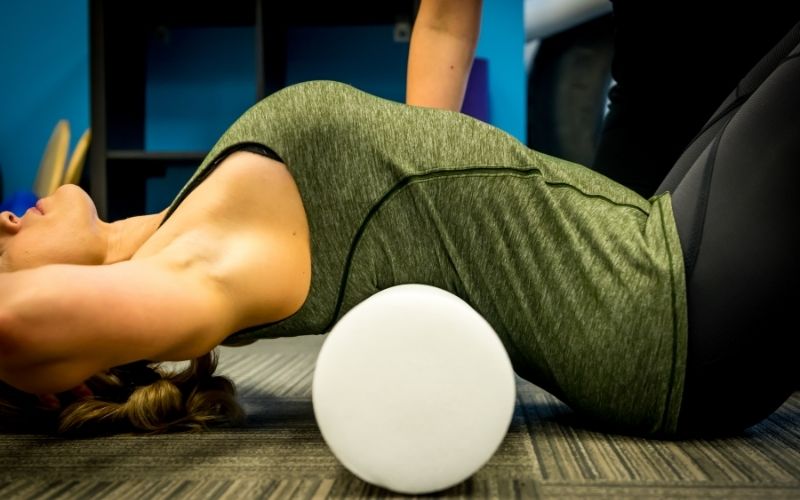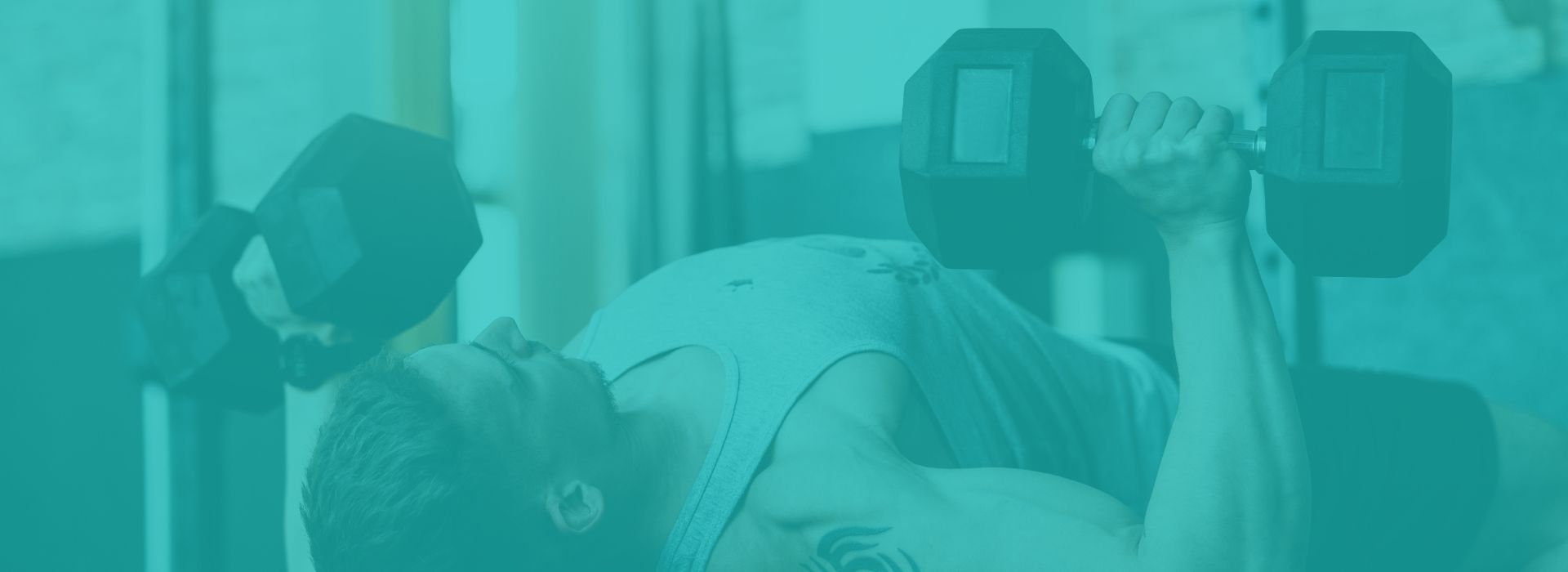Culturally synonymous with strength, the chest is roughly identifiable as the area of our pectoralis muscles and is an important aspect of both our functional and structural anatomy. Undergoing chest physiotherapy can restore functionality and reduce pain.
As the main axial attachment for our arms, the chest not only protects vital organs and bones but allows full function of the upper limb. Important in giving us the ability to lift, pull and throw the chest allows us to sustain an enjoyable, active lifestyle.
The onset of unexpected chest pain is one of the first symptoms of a heart attack and emergency services should be called immediately… However, other forms of chest pain caused by direct blows, and uncomfortable shoulder movements can be directly assessed by our physiotherapists who can inform you of your chest physio options.

PRIMARY FUNCTION OF THE CHEST
Due to its position and responsibilities within the body, the chest has several protective and functional roles. As sudden-onset chest pain is the first symptom of a heart attack, emergency services should be contacted on 000/112 immediately if this does occur.
The structural, skeletal framework of the chest is made up of the ribs and sternum, with the superior and lateral borders provided by the clavicles (collar bone) and shoulder/arm respectively, and posterior attachments to the spine and scapulae.
Our ribs support the upper body and act as a bony cage to protect the underlying organs and soft-tissues; including the heart, lungs and associated blood vessels. Mobile, cartilaginous attachments of the rib cage means that it can actively expand and compress to assist with breathing.
Active breathing is very important when we are exercising or under stress to help increase respiration and therefore the oxygen available to the body.
The primary function of the chest musculature is the control and movement of the shoulder and arm. The main muscles of the chest are the Pectoralis (Pec) Major and Pectoralis (Pec) Minor.
Pec Major enables the shoulder and arms to move whilst staying connected to the thorax and is the principal muscle for flexion, extension, adduction and medial rotation of the humerus (upper arm).
The Pectoralis Minor is a key muscle in the rotation of the shoulder blade and is also connected to the ribcage, assisting with bending, twisting and active respiration.
Keeping the chest functioning properly is a key element to your health. Understanding and assessing if discomfort requires chest pain rehab or immediate action is vitally important.
IS IT A HEART ATTACK?
It is important to take immediate action if you suffer from sudden-onset, acute chest pain or are with someone who does. The first thing you must do is call 000 as emergency services will provide the best treatment in these situations.
Though there can be little doubt as to the cause of these ‘movie’ type heart attacks, many can begin with only mild chest pain or discomfort.
In situations where someone suspects a heart attack or reports symptoms, it is integral to act quickly and pay attention to the symptoms developing.
These include:
- Chest Discomfort – this can involve a feeling of fullness, pressure, swelling or pain usually located in the centre of the chest.
- Discomfort in surrounding areas – though generally originating in the chest, pain and discomfort can spread to surrounding areas, including one (often left) or both arms, the neck, back, jaw or stomach.
- Shortness of breath – can occur in conjunction with or independent of chest pain.
- Other symptoms can include light-headedness, dizziness, nausea and breaking out in a cold sweat.
It cannot be stressed enough that if any of these symptoms occur and a heart attack is suspected or even a possibility, no matter how remote, you must act quickly as indecision or inaction can and will lead to a fatality.
CHEST ANATOMY, INJURIES & SYMPTOM
As a highly functional part of our anatomy, chest pain or injury can be very debilitating with symptoms often indicative of the issue.
RIB INJURIES
There are 12 pairs of ribs in the body. Each rib attaches posteriorly to the spine via costovertebral joints. Anteriorly, the first seven pairs connect to the sternum through direct, cartilaginous sternocostal joints and are referred to as ‘true’ ribs.
The next three ribs are called ‘false ribs’ and they attach to the sternum through a joint costal cartilage onto the seventh rib. The final two pairs do not have an anterior attachment and therefore are referred to as the ‘floating’ ribs.
As stated before, the ribs are an important, mobile aspect of our anatomy.
Movement occurs as the action of surrounding musculature consisting of the intercostal muscles, diaphragm, pectoralis minor, sternocleidomastoid and scalene group.
Severe damage to the ribs or surrounding tissue may cause life-threatening internal damage if not treated correctly and quickly.

RIB FRACTURES AND CHEST PHYSIOTHERAPY
Fractures/breaks are the most common acute rib injury. Usually caused by direct, traumatic force such as in a motor vehicle accident, fall or sporting collision; fractures normally occur in the middle portion of the rib cage. Though traumatic force is the usual mechanism of injury, if bone degradation or osteoporosis are present, actions as simple as sneezing or heavy coughing can cause fracture.
SYMPTOMS
The main symptom of a fractured rib is sharp, severe pain at the site of injury immediately post trauma. Pain can increase when coughing, sneezing, laughing, deep breathing or movement. Injury is often accompanied by bruising, inflammation and swelling.
Though symptoms will often clearly indicate a fracture, it is important to get the injury assessed by an appropriate medical professional to determine the magnitude of the injury and whether there is any internal damage.
TREATMENT
A comprehensive assessment from a physiotherapist will determine these factors and if required X-Ray, MRI and CT scans are used for confirmation diagnosis of the injuries.
Treatment will vary depending on the severity and location of the fracture. Ice and anti-inflammatory medications (i.e. Nurofen) in conjunction with physiotherapy will assist in a complete and timely recovery and return to activity.
The physiotherapy Brisbane team at Pivotal Motion offers chest physio treatment that includes manipulations and mobilisations, muscle activations, taping, education or advice on returning to work/sports and how to manage and prevent the injury in the future. Biomechanical assessments are also performed to ensure the injury does not become a recurrent or chronic issue.
STERNAL INJURIES
The sternum, or breast bone, provides anterior attachment for our upper ribs, clavicles and pectoralis major muscles. Though often identified as a singular bone, the sternum consists of three different parts, fused together via cartilaginous joints.
The three bones which make up the ‘sternum’ are the manubrium (superior/upper), the body (middle) and the xiphoid process (inferior/lower).
STERNAL FRACTURES AND CHEST PHYSIOTHERAPY
Sternal fractures are an uncommon injury due to the huge amount of force required to cause sufficient damage. Injury will generally occur via direct trauma to the anterior chest wall, such as in a motor vehicle accident whereby the chest impacts the steering wheel or seatbelt.
Though less regular, fractures can be caused at much lower forces, these generally occur in individuals suffering from osteoporosis, repeated stress (i.e. golfers or weightlifters) or who have had cardiothoracic surgery.
On occasion fracture may occur due to excessive flexion of the chest (usually in a traffic accident) or collision with another player in contact sports.

SYMPTOMS
Symptoms of a sternal fracture include intense, localized pain immediately post-trauma, tenderness, bruising, swelling and inflammation. Patients can also report breathing difficulties and pain when laughing, coughing or sneezing.
If the fracture is severe enough there may be deformation and pain will increase with movement or when lying prone.
Though fractures can be simple and straightforward to treat, sternal fractures require careful assessment as they can be associated with internal damage to the heart or lungs.
TREATMENT
Diagnosis of a fracture will require examination from either a doctor or physiotherapist and X-Ray will be used to confirm the diagnosis.
Treatment of sternal fractures will usually remain conservative if displacement and internal damage are not present. Major aims of treatment will be to decrease pain and improve function through progressive physical and exercise management.
Application of ice and at times heat may help with temporary pain relief. Use of anti-inflammatories are to be avoided as it inhibits healing of the bone. Once the fracture has healed, physiotherapy will include a range of manual therapy in conjunction with stretching and strengthening exercises.
Improvements will be gradual and a progressive return to activity will be developed to aid in a complete and timely recovery. If there are complications from the injuries such as cardiac contusion, surgery may be required, this will change the treatment plan however physiotherapy will still be necessary to return function.
MUSCULAR STRAIN/TEARS OF THE CHEST
GENERAL MUSCULAR STRAIN INFORMATION
The most common cause of muscle pain (myalgia), especially in the chest, is muscle strain or tear. Also referred to as a ‘pulled’ muscle, these injuries can range from mild strain to a full rupture and include damage to the muscle-tendon junction (MTJ). Possible from either acute, traumatic events or as a result of fatigued or repetitively strained muscles, the length and method of chest pain rehab will be dependent on the severity and mechanism of injury.

SYMPTOMS
General symptoms of muscle strains/tears include muscle tightness (also a predisposing factor), swelling, bruising, inflammation, pain, tenderness and a loss of function (range of motion and strength. However, as stated previously, muscle strains will differ in magnitude and therefore, similar to ligaments, severity can be diagnosed via a grading system:
Grade 1 (Mild): A limited number of muscle fibres are torn and pain/tenderness is localised There is no loss of strength or either active or passive range of motion (ROM).
Grade 2 (Moderate): A large number of muscle fibres are torn. Acute and increased pain is present causing swelling/pain reduced ROM. Mild strength deficit is present.
Grade 3 (Severe): Involves a complete rupture (tear) of either the MTJ or of the muscle belly. Severe pain and swelling are present with major/complete loss of strength and ROM. Obvious visual defects are also common symptoms.
Immediate treatment of muscle injuries requires the RICE (Rest, Ice, Compression and Elevation) be followed and that the patient avoids HARM (Heat, Alcohol, Running and Massage). It is important that a physiotherapist is consulted quickly post-injury to ensure a complete and timely recovery and so return to activity.
PECTORALIS MAJOR
The Pectoralis (Pec) Major originates from the sternum, ribs and clavicle to attach on the humerus (upper arm). The key agonist muscle during arm flexion, extension, adduction and medial (internal) rotation, the pec major is very important for a number of upper limb movements required in sport, weightlifting or activities of daily living.
Due to its large responsibility through movement, strains and tears of the pec major can be debilitating and very painful. Also due to the different muscle sizes and contributions to movement Pec Major injury is the more common versus Pec Minor strain or tear.
As with all muscle strains/tears, pec major injury can be caused by overuse or acute overload. Overuse injuries are common in weightlifting athletes or individuals undertaking a large amount of training.
Deterioration and repetitive strain can weaken the muscle and tendon tissues to a stage where increases/changes in load cause rupture. However, more common mechanism of injury include: acute overload, whereby a force is applied to the tissue which is greater than it can withstand; or a forced contraction in a stretched position. Incidence of pectoral strains increase in older athletes and if a proper warm-up is not completed.
SYMPTOMS & TREATMENT
Symptoms will depend on the grade of tear but include immediate pain and a tearing sensation through the movement responsible for injury. Pain will generally be localized to the chest or front of the upper arm (tendinous attachment) and is usually an ache which increases with activity. The site of injury may be tender and painful during movement, swelling, bruising and deformity may also be present.
Immediate treatment will require the RICE protocol as stated above. It will be important to report to a physiotherapist so the injury can be assessed to diagnose severity and begin the recovery process. At Pivotal Motion Physiotherapy our treatment will include strategies to relieve pain and discomfort; aiding of the healing of the muscle and then designing a progressive return to activity plan including both manual therapy and strengthening/stretching exercises.
PECTORALIS MINOR
Though less likely to tear, Pectoralis Minor can cause a range of significant issues when tight or overactive. The Pec Minor lies deep, underneath the Pec Major and originates from ribs 3-5 to insert on the coracoid process of the scapula (near lateral/outer joint of clavicle).
The primary role of the Pec Minor is to stabilize the scapula (and therefore shoulder position) by drawing it inferiorly and anteriorly, down and forward, against the thoracic wall.
SYMPTOMS & TREATMENT
If the Pec Minor is chronically tight it can entrap nerves running under the arm or even ‘wing’ the scapula, whereby the medial and inferior aspects are raised out of position. These can cause major structural and biomechanical issues, increasing risk of injury and shoulder impingement or permanent damage.
It is therefore important that if you notice tightness in your chest just inside the shoulder, or suffer regular pain, to consult a physiotherapist for a diagnosis and treatment. Another symptom of Pec Minor tightness may be a severe ‘rolling’ of shoulders or the ‘winged’ scapulae. In order to remedy these issues before they exacerbate, come in to Pivotal Motion where we can assess the problem and aid in a complete and timely recovery.
Treatment from our physiotherapists will include manual therapy (trigger points and massage), strengthening exercises to remedy muscular deficiencies and stretching or self-release strategies to loosen the Pec Minor and prevent reoccurrence of the issue.
THORACIC OUTLET SYNDROME (TOS)
The thoracic outlet is the area extending from the groove between ourfirst rib and clavicle down to our armpit. This portal is very important as through it the brachial plexus and the subclavian and axillary veins and arteries exit the axial skeleton to provide innervation and blood supply to the arms.
TOS therefore is a general term given to disorder which cause compression of these structures. Due to conjecture over the classification of different types of TOS, historically the disorder has been poorly diagnosed and managed.

TOS NOW REFERS TO THE RANGE OF HETEROGENOUS DISORDERS WHICH FOLLOW:
- Arterial Vascular TOS: Most common in young adults this syndrome refers to compression of the artery causing compromised or turbulent blood flow.
- Venous Vascular TOS: This syndrome is more common in adults and results from the compression of either the subclavian or axillary veins as it exits the Thoracic Outlet.
- Traumatic Neurovascular TOS: Is caused by trauma to the mid-section of the clavicle and is name so due to the neurological and vascular symptoms. This syndrome can be a direct result of the trauma (e.g. damage due to the fracture type/mechanism) or secondary as the result of the fracture (e.g. malunion, poor management of the fracture).
- True Neurological TOS: This form of TOS is very rare, suffered by only one person in every million. Often confused with other upper limb pathologies, true neurological TOS is caused by pressure from a taunt, fibrous band o the nerve bundles exiting the thoracic outlet.
- Non-specific TOS: Unlike the other forms of TOS this syndrome is commonly bi-lateral; affecting both sides of the body. Termed ‘non-specific’ due to an unclear pathogenesis; theories exist regarding its cause including compression/traction of the brachial plexus due to trauma, congenital or fibromuscular abnormalities or even postural dysfunction.
SYMPTOMS & TREATMENT
Symptoms of TOS will depend on the classification of the syndrome. Treatment is initially conservative (i.e. postural correction, manipulation or strength/ROM corrections) and is applicable via our physiotherapists at Pivotal Motion. Surgical intervention however is always recommended for true neurological and arterial vascular TOS with physiotherapy treatment required for rehabilitation and recovery.
CHEST INJURY AVOIDANCE & RECOVERY
Due to its uses, a pectoral injury can limit day-to-day living. Thankfully, there are a few things that can help limit the chance of an injury, as well as assist in the recovery stage. For athletes and gym-goers, it is essential to properly warm up the muscles before exercising. Combined with the correct lifting form and technique, most injuries can be avoided.
When recovering, it is important to not overstretch the recovering muscle group, as the body initiates what is known as “muscle guarding”, which tightens the affected muscles to prevent further damage. Light stretching and chest physiotherapy treatments will assist in strengthening the affected and surrounding muscles, but rest is the key recovery method recommended.
IF YOU ARE SUFFERING FROM CHEST PAIN AND LOOKING FOR A ‘CHEST PHYSIOTHERAPIST NEAR ME’ SEE THE FRIENDLY PHYSIOTHERAPY BRISBANE TEAM AT PIVOTAL MOTION TODAY!
BOOK AN APPOINTMENT ONLINE OR CALL US ON 07 3352 5116 TODAY!

